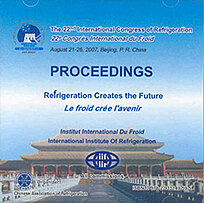
Document IIF
Effets d'un entreposage à -2 à 3°C sur les caractéristiques du saumon fumé avant la mise en vente.
Effects of storage at -2/3°C before retail displaying on the qualities of smoked salmon.
Auteurs : BEAUFORT A., BOURDIN G., LEBAIL A., et al.
Résumé
Deep chilling is a technology consisting in storing smoked salmon at -2/-3°C during several weeks before retail displaying. This approach is an important point for controlling production and retail chain logistics. In the agro-food industry, cold storage is made either at positive temperature in order to slow down the growth of bacteria or at negative temperature (freezing) in order to stop the growth of bacteria. Storing food between 0°C and the freezing point is an alternative and the results on microbial and sensorial qualities have been investigated in a research programme aiming at: highlighting determinant factors for the growth of Listeria monocytogenes: salt content, cold stiffening before slicing, kinetic characteristics of the strain, chilling duration; assessing the consequences of chilling on Listeria monocytogenes growth; assessing the impact of chilling on sensory changes. Results permitted to assess the impact of this technology on the final product and will help to determine the commercial shelf life of the smoked salmon. They will also contribute to collect scientific data for a quantitative risk assessment.
Documents disponibles
Format PDF
Pages : ICR07-C2-103
Disponible
Prix public
20 €
Prix membre*
Gratuit
* meilleur tarif applicable selon le type d'adhésion (voir le détail des avantages des adhésions individuelles et collectives)
Détails
- Titre original : Effects of storage at -2/3°C before retail displaying on the qualities of smoked salmon.
- Identifiant de la fiche : 2008-0289
- Langues : Anglais
- Source : ICR 2007. Refrigeration Creates the Future. Proceedings of the 22nd IIR International Congress of Refrigeration.
- Date d'édition : 21/08/2007
Liens
Voir d'autres communications du même compte rendu (839)
Voir le compte rendu de la conférence
Indexation
- Thèmes : Poissons et produits de la mer
- Mots-clés : Qualité; Saumon; Entreposage frigorifique; Fumaison
-
Evaluation of sensory quality during freezing a...
- Auteurs : SORENSEN N. K., GUNDERSEN B., NYVOLD T. E., ELVEVOLL E.
- Date : 20/03/1996
- Langues : Anglais
- Source : Refrigeration and Aquaculture.
- Formats : PDF
Voir la fiche
-
Effect of icing and storage temperatures on sal...
- Auteurs : MAGNUSSEN O. M., JOHANSEN S., NORDTVEDT T. S.
- Date : 20/03/1996
- Langues : Anglais
- Source : Refrigeration and Aquaculture.
- Formats : PDF
Voir la fiche
-
Lipid-protein interactions in fish during cold ...
- Auteurs : Ifremer, FIOM, UNDELAND I.
- Date : 12/11/1997
- Langues : Anglais
- Source : Proceedings of the Final Meeting of the Concerted Action "Evaluation of Fish Freshness" AIR3CT94 2283: Methods to Determine the Freshness of Fish in Research and Industry.
- Formats : PDF
Voir la fiche
-
THE SURVIVAL AND GROWTH OF LISTERIA MONOCYTOGEN...
- Auteurs : MACRAE M., MILLAR I. G., GIBSON D. M.
- Date : 18/09/1990
- Langues : Anglais
- Source : Chilling and Freezing of New Fish Products.
- Formats : PDF
Voir la fiche
-
Estimate of postmortem loss of fish freshness w...
- Auteurs : POLI B. M., GERI G., MASCINI M., PARISI G., MECATTI M., GUIDOTTI P.
- Date : 20/03/1996
- Langues : Anglais
- Source : Refrigeration and Aquaculture.
- Formats : PDF
Voir la fiche
